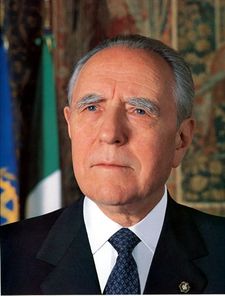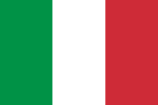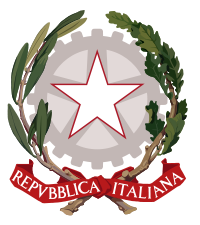Carlo Azeglio Ciampi
| Senator Carlo Azeglio Ciampi |
|
 |
|
|
10th President of Italy
|
|
|---|---|
| In office 18 May 1999 – 15 May 2006 |
|
| Prime Minister | Massimo D'Alema Giuliano Amato Silvio Berlusconi |
| Preceded by | Oscar Luigi Scalfaro |
| Succeeded by | Giorgio Napolitano |
|
73rd Prime Minister of Italy
|
|
| In office 28 April 1993 – 10 May 1994 |
|
| President | Oscar Luigi Scalfaro |
| Preceded by | Giuliano Amato |
| Succeeded by | Silvio Berlusconi |
|
Italian Minister of Tourism
|
|
| In office 28 April 1993 – 10 May 1994 |
|
| Prime Minister | himself |
| Preceded by | Margherita Boniver |
| Succeeded by | Domenico Fisichella |
|
Italian Minister of the Interior
|
|
| In office 19 April 1994 – 10 May 1994 |
|
| Prime Minister | himself |
| Preceded by | Nicola Mancino |
| Succeeded by | Roberto Maroni |
|
Italian Minister of Exchequer, Budget and Economy Programming
|
|
| In office 17 July 1996 – 13 May 1999 |
|
| Prime Minister | Romano Prodi Massimo D'Alema |
| Preceded by | Lamberto Dini as Minister of exchequer Mario Arcelli as Minister of budget and economy programming |
| Succeeded by | Giuliano Amato |
|
Governor of Banca d'Italia
|
|
| In office 1979–1993 |
|
| Preceded by | Paolo Baffi |
| Succeeded by | Antonio Fazio |
|
|
|
| Incumbent | |
| Assumed office 18 May 2006 |
|
| Constituency | Former president |
|
|
|
| Born | 9 December 1920 Livorno, Italy |
| Nationality | Italian |
| Political party | Democratic Party |
| Spouse(s) | Franca Pilla |
| Residence | Rome, Italy |
| Alma mater | Scuola Normale Superiore di Pisa University of Pisa |
| Profession | Economist Politician |
| Religion | Roman Catholicism |
Carlo Azeglio Ciampi (Italian pronunciation: [ˈkarlo aˈdzɛʎʎo ˈtʃampi] (![]() listen); born 9 December 1920[1]) is an Italian politician and banker. He was the 73rd Prime Minister of Italy from 1993 to 1994 and was the tenth President of the Italian Republic from 1999 to 2006. He is currently a Senator for life in the Italian Senate.
listen); born 9 December 1920[1]) is an Italian politician and banker. He was the 73rd Prime Minister of Italy from 1993 to 1994 and was the tenth President of the Italian Republic from 1999 to 2006. He is currently a Senator for life in the Italian Senate.
Contents |
Biography
Education
Ciampi was born in Livorno (Province of Livorno).[1]
After receiving a degree in literature in 1941 from the Scuola Normale of Pisa, one of the country's most prestigious universities, he was called to military duty in Albania as a lieutenant. On 8 September 1943, the date of the armistice with the Allies, he refused to remain in the Fascist Italian Social Republic, and took refuge in Abruzzo, in Scanno. He subsequently managed to pass the lines and reach Bari, where he joined the Partito d'Azione (and thus the Italian resistance movement).
In 1946 he married Franca Pila. That same year, he obtained a degree in law from the University of Pisa and began working at the Banca d'Italia. He also inscribed to CGIL, a member of which he remained until 1980.
Oxford University awarded him an Honorary Doctor of Civil Law degree in March 2005.
Career in the Banca d'Italia
In 1960, he was called to work in the central administration of the Banca d'Italia, where he became Secretary General in 1973, Vice Director General in 1976, and Director General in 1978. In October 1979, he was nominated Governor of the Banca d'Italia and President of the Ufficio Italiano Cambi, positions he filled until 1993.
Prime Minister
From April 1993 to May 1994, he was the Italian Prime Minister overseeing a technical government. Later, as Treasury Minister from 1996 to May 1999 in the governments of Romano Prodi and Massimo D'Alema, he was credited with adopting the euro currency. He personally chose the Italian design for the 1-euro coin, whereas all others were left to a television vote among some candidates the ministry had prepared. (See also: Italian euro coins)
Ciampi chose the Vitruvian man of Leonardo da Vinci, on the symbolic grounds that it represented man as a measure of all things, and in particular of the coin: in this perspective, money was at the service of man, instead of its opposite. The design also fitted very well on the bimetallic material of the coin.
President of Italy
Ciampi was elected with a broad majority, and was the second president ever to be elected at the first ballot (when there is a requirement of a two-thirds majority) in a joint session of the Chamber of Deputies, the Italian Senate and representatives of the Regions.
He usually refrained from intervening directly into the political debate while serving as President. However, he often addressed general issues, without mentioning their connection to the current political debate, in order to state his opinion without being too intrusive. His interventions have frequently stressed the need for all parties to respect the constitution and observe the proprieties of political debate. He was generally held in high regard by all political forces represented in the parliament. The possibility of persuading Ciampi to stand for a second term as President - the so-called Ciampi-bis - was widely discussed, despite his advancing age, but it was officially dismissed by Ciampi himself on 3 May 2006, just a few days before his mandate expired. Ciampi resigned as President before the swearing-in ceremony of his successor, Giorgio Napolitano.
As President, Ciampi was not considered to be close to the positions of the Vatican and the Catholic church, in a sort of alternance after the devout Oscar Luigi Scalfaro. He has often praised patriotism, not always a common feeling in Italy because of its abuse by the Fascist regime; Ciampi, however, seems to want to stress self-confidence rather than nationalism.
On 5 May 2005, he received the Charlemagne Award of the city of Aachen. On 15 June 2005, he was awarded an honorary doctorate by the École Normale Supérieure of Paris.
On 1 May 2008, he attended Charlemagne Award of the city of Aachen.
References
- ↑ 1.0 1.1 Page at Senate website (Italian).
| Government offices | ||
|---|---|---|
| Preceded by Paolo Baffi |
Governor of Banca d'Italia 1979 - 1993 |
Succeeded by Antonio Fazio |
| Political offices | ||
| Preceded by Giuliano Amato |
President of the Council of Ministers of Italy 1993 - 1994 |
Succeeded by Silvio Berlusconi |
| Preceded by Margherita Boniver |
Italian Minister of Tourism and Show 1993-1994 |
Succeeded by Domenico Fisichella |
| Preceded by Nicola Mancino |
Italian Minister of the Interior 1994 |
Succeeded by Roberto Maroni |
| Preceded by Lamberto Dini and Mario Arcelli |
Italian Minister of exchequer, budget and economy programming 1996-1999 |
Succeeded by Giuliano Amato |
| Preceded by Oscar Luigi Scalfaro |
President of the Italian Republic 1999-2006 |
Succeeded by Giorgio Napolitano |
| Order of precedence | ||
| Preceded by Oscar Luigi Scalfaro Former President of the Italian Republic |
Italian order of precedence Former President of the Italian Republic |
Succeeded by Vice Presidents of the Italian Senate |
|
||||||||||||||||||||||||||||||||||||||||||||||||||||

.svg.png)

